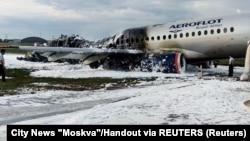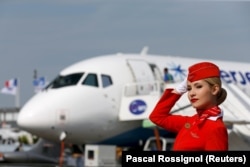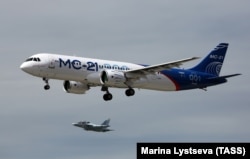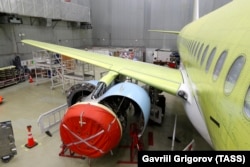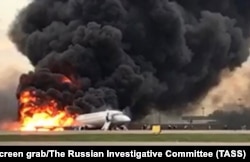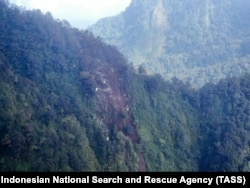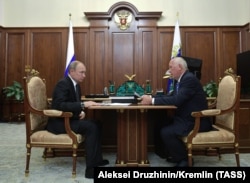In November 2006, nine months after signing a decree creating United Aircraft Manufacturing Corp (UAC), Russian President Vladimir Putin invited the state-controlled conglomerate’s newly chosen CEO, Aleksei Fyodorov, and top cabinet officials overseeing the industry to the Kremlin to discuss future plans.
“We are all aware that our biggest problems are in civil aviation, and so we will be focusing particularly on this area,” Fyodorov told Putin at the meeting. “Our main focus will be on new projects.”
Putin had combined Russian warplane and commercial aircraft producers, including Sukhoi, Ilyushin, Tupolev, and Irkut, under the roof of UAC --an effort to strengthen state control over the crucial sector, which was struggling 15 years after the Soviet Union’s collapse, and improve efficiency.
Another 15 years later, Russia’s civil aviation industry is at risk of collapsing under the weight of Western sanctions over the invasion of Ukraine. Despite billions of dollars pumped into the sector with much fanfare, there’s been little to show for it -- and reliance on Western planes, technology, and spare parts remains sky high.
At the meeting in 2006, Fyodorov told Putin that development of the Sukhoi Superjet 100 (SSJ-100), a short-range plane seating up to 98 passengers and set to become the first post-Soviet, Russian-designed commercial aircraft to go into mass production, was “going ahead quite well.”
He then told Putin about UAC’s “biggest and most important” commercial project: the development of the MS-21, a medium-range plane designed to replace the aging Soviet Tu-154 fleet and to compete with the Boeing 737 MAX and Airbus A320.
“This is one of the company’s most complex and strategic objectives today,” Fyodorov said.
As of today, after plowing more than $3 billion into the project, UAC has yet to deliver a single MS-21 to customers. It has promised to transfer four this year to the state-controlled airline Rossiya, but that is now in doubt due to the sanctions. Mass production at a profitable level is still at least five years away.
As for the SSJ-100, two deadly crashes -- including one on a promotional trip to Asia -- and a persistent lack of spare parts have sapped domestic and international interest.
As of mid-2021, there were only 155 SSJ-100s in operation, according to UAC CEO Yury Slyusar. The demand stemmed largely from government pressure on Russian airlines to buy them, according to industry analysts.
Western-made planes, including Boeing and Airbus, accounted for about 80 percent of Russia’s fleet at the start of the year, according to Cirium, an aviation data and analytics firm. It is a larger proportion than when Putin first came to office.
Many of those planes will be grounded in the coming months after Western nations banned the export of aviation technology, including spare parts, to Russia following its invasion of Ukraine on February 24.
Russia’s airlines will be forced to cannibalize their existing fleets for spare parts, analysts said.
Even the SSJ-100 could be grounded, as most of its components are foreign made, including the engine.
In a potential sign of concern in the Russian government about the situation and how it plays out in public, a senior official of Rosaviatsiya, the nation’s federal air transport agency, was immediately fired after he told an industry conference on March 10 that China had refused to supply Russia with spare parts, the business daily Kommersant reported.
Since the United States and Europe first imposed sanctions on Russia in 2014 for its seizure of Crimea, Russia has been seeking to move away from Western imports, including in the aviation industry.
However, UAC isn’t expected to deliver fully Russian made SSJ-100s until 2024 at the earliest, Slyusar said in October. Russia is still developing an engine for the SSJ-100 to replace the one made by a joint venture with France’s Snecma.
“The reality is that they are in deep, deep trouble unless they can find a way to get these export controls lifted,” Chris Miller, a professor at Tufts University in the United States who has written books on the Soviet and Russian economies, told RFE/RL.
“Russian civil aviation today is just very heavily reliant on components from the U.S., Europe, and Japan, and there's no easy way to replace them in the short term,” he said.
'Failure Of Policy'
That wasn’t always the case.
The Soviet Union produced commercial planes with fully domestic parts. But some of those key components -- especially avionics and engines -- were inferior to Western equivalents.
Soviet aircraft suffered from severe maintenance and reliability problems, including -- like today -- a lack of spare parts. Some airports in Europe banned them for failure to meet regulations and noise emissions.
When the Soviet Union collapsed in 1991 and Russia opened its economy to the world, its airlines sought to acquire better-made and more reliable Western planes.
Russian manufacturers, some now in private hands, suffered financially in the 1990s as orders dried up, raising questions about whether the domestic civil aviation manufacturing industry even had a future.
When Putin came to power in 2000, he faced a formidable uphill battle in turning the sector around.
At a meeting in the Kremlin in 2001, he called on officials and aviation executives to move quicker in carrying out the government's strategy to revive the industry.
It was one of many meetings Putin would hold over the next two decades with policy makers and aviation executives to discuss investments and reforms.
For all the talk, however, analysts say he did not give civil aviation the attention and money it needed to overcome its problems, setting the country up for the crisis it now faces.
“The government did not focus enough on diversification of the economy and spent far too much time living off hydrocarbons,” Chris Weafer, the founder of the Moscow-based consulting firm Macro Advisory, told RFE/RL, highlighting civilian aircraft manufacturing as one casualty of that policy.
Russia is one of the world’s top three producers of oil and gas, which together generate about one-third of budget revenues. Putin benefitted from surging oil prices during his first two terms in office, from 2000 to 2008, and again from 2012 to 2014, early in his third term.
Peter Wilson, an adjunct senior defense analyst at the RAND Corporation think tank and a professor at Georgetown University, who has written about Russian military aviation, said Putin blew an opportunity to use surging oil and gas revenue to modernize the nation’s plane manufacturing industry, including by tackling the age-old problem of avionics and engines.
Putin stockpiled the excess revenue from energy sales to fortify his country against potential Western sanctions instead of investing it to enhance living standards and modernize industry, Wilson said.
Russia’s reserves were the fifth largest in the world prior to the invasion of Ukraine, reaching about $630 billion.
“There was a lot of talk inside the Russian aerospace and defense industry about how they were going to develop their indigenous capabilities…and some of it kind of happened. But fundamentally, it was a failure of policy and investment,” Wilson told RFE/RL.
Some $300 billion in reserves are now frozen by Western sanctions.
'Where Are The Planes?'
UAC initially designed the SSJ-100 and MS-21 with Western components, including avionics and engines, putting Russia’s commercial plane industry in the vulnerable position that it is now seeking to desperately overcome.
But UAC’s problems, including its inability to produce more planes, go deeper than dependence on the West, Russian analysts say.
In a series of articles for the military-focused news agency website Voyenno-Promyshlenny Kuryer analyzing UAC, Igor Semenchenko, a former top adviser to Russia’s upper parliament chamber, the Federation Council, slammed current and past managers and government officials for poor policy decisions, lack of experience, and mismanagement of funds.
He criticized the decision to develop the Sukhoi's SSJ-100 when a Soviet-designed alternative by Tupolev already existed. Tupolev had decades of experience building passenger planes while Sukhoi -- a designer of military jets -- did not, he said, suggesting that was a reason why the plane had so many technical problems.
The SSJ has been haunted by two deadly accidents, including a crash into an Indonesian mountainside during an exhibition flight with 45 people on board in 2012, and has been hobbled by performance issues and lack of spare parts.
According to Semenchenko, the government had to pour so much money into the SSJ-100, including to overcome its problems, that there was little left over for other civilian projects.
“UAC became a highly effective tool for consuming state budget funds” and has turned “into almost a laundering firm,” Semenchenko wrote in a November 2020 article.
Valentina Matviyenko, the head of the Federation Council, raised similar concerns about mismanagement in 2013, saying some state corporations, including UAC, had turned into black holes.
“Huge state investments, hundreds of billions of rubles, were pumped into the UAC. Can someone answer the people: Where are the planes? Where's the money?" he said.
Russia initially planned to build from 60 to 72 SSJ-100s a year with a target to sell 1,000 jets over a two-decade period, including 700 for export. The sales figures were revised lower to roughly 600 jets by 2031 as UAC struggled to find sellers. The coronavirus -- which decimated travel over the past two years -- and now sanctions have made that target optimistic.
Since 2008, UAC has produced about 220 SSJ-100s with just 159 currently in operation, nearly all of them in Russia.
The weak sales left UAC mired in debt, forcing the government to step in with a $4 billion bailout package in 2019. UAC has been loss-making nearly its entire existence.
Analysts have said UAC’s initial forecasts for SSJ-100 sales were unrealistic because the market for short-haul planes isn’t that large. They speculated UAC made the outlandish projection to receive more government funding.
As relations with the West worsened and the threat of more sanctions loomed, Putin in 2020 approved new measures to subsidize the purchase of SSJ-100 jets by domestic operators.
Under that program, the leasing arm of Rostec, the state-owned defense conglomerate that controls UAC, agreed to buy dozens of SSJ-100s, as did other Russian airlines, for delivery in the next few years.
Rostec is run by Sergei Chemezov, 70, a longtime friend and associate who worked with Putin when both were KGB officers stationed in Dresden, East Germany, in the 1980s. He has been accused of enriching himself in that position, a charge he denies.
Chemezov last year tapped himself as chairman of UAC. He will now oversee Russia’s efforts to break the aviation sanctions stranglehold by producing fully domestically made planes.
Aviation experts have said that the tendency to hand high-level jobs and responsibilities to people close to Putin is part of the problem, not the solution to Russia’s aviation troubles.
UAC is “incapable of innovation and adaptation” because its directors are largely “handpicked yes-sayers” who lack skills as industrial managers, Tom Cooper, a military aviation analyst who follows Russia, said in a 2017 article.




